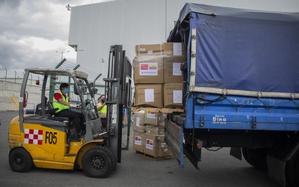 Chinese medical supplies arrive in Quito, Ecuador, on April 17, 2020. (PHOTO / XINHUA)
Chinese medical supplies arrive in Quito, Ecuador, on April 17, 2020. (PHOTO / XINHUA)
Ecuador and Peru share a border as Andean nations and the burden of coping with severe coronavirus outbreaks. Their governments also sent voters to polling booths on the same day for presidential elections this month.
For Ecuador, the voting on April 11 was for a runoff between Guillermo Lasso, a financial executive, and Andres Arauz, a former government minister. Lasso prevailed with more than 52 percent of the votes.
While Ecuador's path out of the economic hardships caused by the pandemic is clearer with a settled government, Peru remains mired in uncertainty as the country heads to runoff elections on June 6. On April 11, in an inconclusive first-round vote Pedro Castillo, a schoolteacher and union leader, won 19 percent of the vote, ahead of Keiko Fujimori, a former member of congress and the daughter of jailed former president Alberto Fujimori, on 13.3 percent.
All the while, both countries have been receiving support from China as recipients of COVID-19 vaccines, as with many countries in Latin America. These supplies will prove vital in their recovery efforts.
In Ecuador, Lasso's win means leaving behind the era of Rafael Correa, a former president who was sentenced in absentia to eight years in prison for corruption and now lives in exile in Belgium.
The country of almost 18 million people has enjoyed increasingly close ties with China. It has also received a $6.5 billion debt bailout from the International Monetary Fund.
On April 7 a first batch of CoronaVac, a COVID-19 vaccine developed by China's Sinovac Biotech, arrived in the country. Outgoing president Lenin Moreno was on hand to receive the shipment.
ALSO READ: Ecuador indigenous community fears extinction from COVID-19
Everything will depend on two factors. One, how quickly the population can be vaccinated....
Pablo Lucio Paredes, director of the Institute of Economics at the San Francisco de Quito University
Curbing outbreaks
The vaccines will be crucial to helping the country overcome one of the worst outbreaks of COVID-19 in the region and get the economy moving. Ecuador had more than 358,100 infections and more than 17,600 deaths by Sunday, Johns Hopkins University data shows.
"Everything will depend on two factors. One, how quickly the population can be vaccinated. Two, what level of external and internal confidence can be generated about government policies so that this positively impacts investors, consumers and financiers," said Pablo Lucio Paredes, director of the Institute of Economics at the San Francisco de Quito University.
Paredes believes that Lasso's election victory will encourage domestic and foreign investors.
"Under this scenario, the latest IMF forecasts of GDP growth of 2.5 percent should be surpassed with a trend of over 4 percent," he said.
Across the border in Peru, the uncertainties stem from a political crisis in which four presidents have run the country in the past three years.
The emergence of Castillo and Fujimori as the final candidates in the runoff elections was seen as something of a surprise.
"The (success) of Keiko (Fujimori) and of Castillo was something that was not even on the radar until the week before elections," said Ramon Abasolo, a lawyer and political analyst in the capital Lima. "It is difficult to know if the political crisis will be over soon. The new congress is very much fragmented, and there is no party with a majority that can lead to a consensus."
Peru, with about 33 million people, had more than 1.69 million COVID-19 infections, with over 56,700 deaths by Sunday, Johns Hopkins University data shows.
READ MORE: Peru, with most-deadly toll, sets grim record as world tally 40m
The author is a freelance writer for China Daily.


